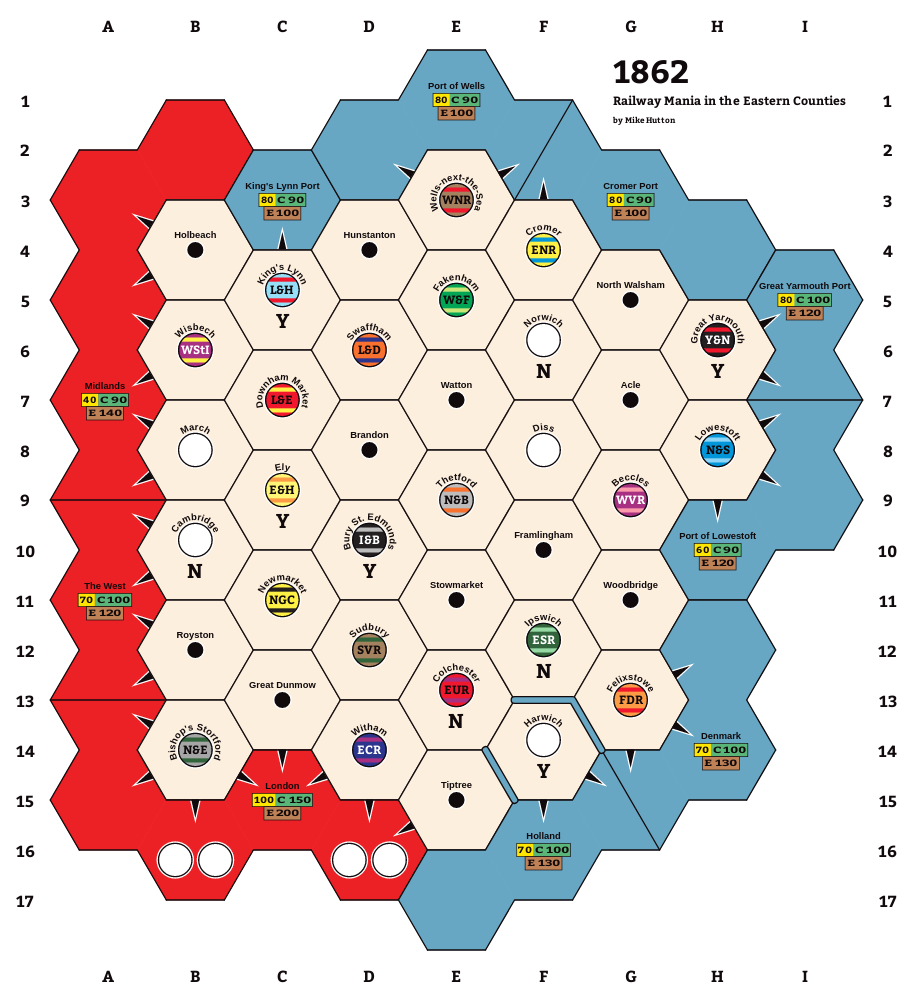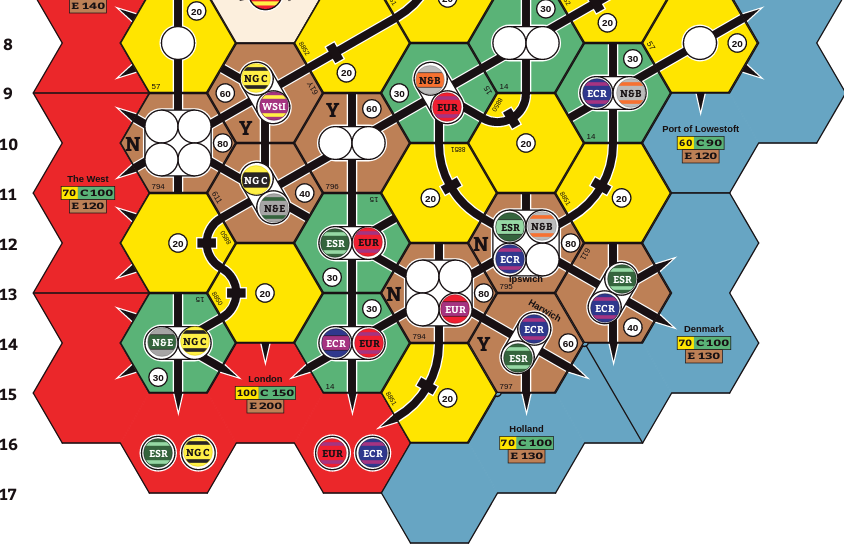- Express (E) which count only large stations and off-board areas. This is the most simple train type conceptually.
- Local (L) which count large stations and small towns along the route but may not run to off-board areas. Moreover, the company itself receives $10 per hex visited which is called a subsidy and this money is paid to the company just for running the trains (regardless of payout or not).
- Freight (F) which can run stations and off-board areas but only count the starting an ending locations with $20 per hex in between (as the crow flies). This increases to $30 per hex if one of the ends is a port.
1862, An arms race
May 4, 2020
This game is a bit of a brain burner like 1817 featuring not only company mergers and acquisitions but also different types of trains and a mix of partial and full capitalization! Add to this fact a very small map, lots of companies, random starting configurations with random assignment of permits, it can quickly get overwhelming.

The three different types of trains are:
The train madness does not end there. If a company owns multiple trains, then:
- One of the trains must include the company's home station.
- Each train must intersect with another train in a city (not town, not offboard). Note that a terminating station (not necessarily of the operating company) may be used as a connection point.
- Trains may reuse track and stations, however each location is only counted once for all the trains combined.
- A train may not visit 2 red off-board locations, nor 2 ports.
- Non-permanent Freight trains need to be chained together. Permanent Freight trains may operate independently but a non-permanent one needs to latch on to a permanent one (if running).
The game opens directly with two Parliamentary rounds (PR) followed by a Stock round (SR). The PR features
bidding to start a chartered company and buying the president's certificate. A chartered company is a
company that is fully capitalized at floatation and an unchartered company is one that is partially
capitalized. Unchartered companies may be started in the SR but the key difference is that the best located
companies will likely be bid for and be gone by the time the SR comes around. Par prices are 54, 58, 62, 68,
74, 82, 90, 100 with the requirement of 50% of a company's shares to be sold in order that it can float.
Thus, in a 4 player game with $600, one could potentially float 2 companies at 58*5 = 290 and
have $20 left over for bidding, or bid 25 and float a company at 54 and the other at 58.
Chartered companies are required to pay 180 for 3 tokens right off the bat whereas unchartered companies can buy between 2 and 7 tokens at 40 each depending upon the director's choice. Thus, a 58 par for a chartered company will result in 400 for the company.
In my experience, running companies that help each other in building track is critical. Synergy matters a lot and can be the difference of over 100% in payouts compared to the competition! As an example, one could have two companies helping lay track for a train with an L permit or two companies helping one with a F permit get from a port to London. Moreover, in order to merge/acquire companies, they need to be connected via track so it is imperative to build towards each other from the start.

This game has 2 major escape hatches:
- One can get rid of a company by simply selling the presidency into the market. If selling a company that has a train, one gets the market value, however, selling shares in a company that does not have a train provides only 50% of the share value. A zombie company that has a train simply runs, retains revenue and attempts to buy the next available train.
- Each company is required to have a train (regardless of whether it has a route) and if a company finds itself trainless at the end of its operating round, then it can sell stock from its treasury to raise money. If selling stock would not be enough to buy a train, the company refinances which involves diluting its stock 2 for 1 and receiving 10x its par value (upto a maximum of $1000).
Due to the number of moving parts and player incentives, I have had to revise the strategy section after having had a few plays online. Essentially, at the start of the game one can run a company to milk it, i.e. get 3 A trains (one with 2 warranties), which will subsequently make as much money as possible and can then be chucked. Companies in the north next to a port are great candidates here. The second option is to get a company with a bright future in the south and shoot to get a B train by getting an A train with 2 warranties and a B train in the second OR.
In the mid-game it is essential to achieve a par value of atleast $80 so that a refinance will ensure buying a permanent train. This should be doable by merging two existing companies or by starting a new company with a high enough par. Merging is beneficial as it provides a company with different types of permits which helps it reuse existing routes. Note that an early merger could mean that one might get to run their A trains 1 more time which would be really beneficial. Some more tips:
- In the initial SR, rather than bidding up a charter, it might be more beneficial to simply invest in the company in question.
- Tokening the smaller cities is better as they are choke points. The N cities open up to 4 spots in brown.
- Try to have an odd number of shares which allow redeeming options in case of merger/refinance.
- As an extension of the above point, invest early in the competition in order to deny them complete control and/or tank their stock price when necessary.
- Keep a minimum of 5 shares in your lead company otherwise you might lose it on a refinance. Note that on refinance, the director's certificate is exchanged for shares and then re-exchanged based on the number of holdings one ends up with.
- Start later companies as unchartered which will allow setting market values higher than $100 (note that 200 is the highest unchartered par possibility), pumping them with cash, operating before other companies and rusting their trains.
- As a collorary to the above point, getting a stock price over 200 is incredible as it essentially means that the company's trains are not at the mercy of newly started companies.
- The last D train should be bought with 2 extra warranties or 1 extra warranty at the minimum. Anything less and it is better off refinancing and shooting for a permanent.
- When the permanents are looking to come out, it might be beneficial to simply sell off everything and start new companies to rust trains and get the cheaper permanents. Note that this is a risky move as it could mean that you are giving up on a well setup network and that the new company does not have the right track/permits to actually use the permanents efficiently.
- Generally, to get payouts of 1300 and above, 3 permanents are required, so depending upon your setup try to shoot for atleast 2 permanents in a company.
Finally, in a crazy twist, note that refinancing for $1000 might even allow one to buy 2 permanents in case the company already had ~600 treasury cash! Thus, unlike other 18xx, one is almost punished for withholding to get the first permanent. Given this refinancing scam, this game is mostly an arms race towards making money :).
While this game might feel a bit broken initially if you are coming from playing standard 18xx where company liablitiy weighs heavy on your mind, there is something exhilarating about making mad gobs of $$$ and at a certain point I could feel myself in the shoes of a 1860's english railroad financier, which has never happened to me while playing an 18xx before!
Many thanks to Love Brandefelt for reviewing this strategy guide.